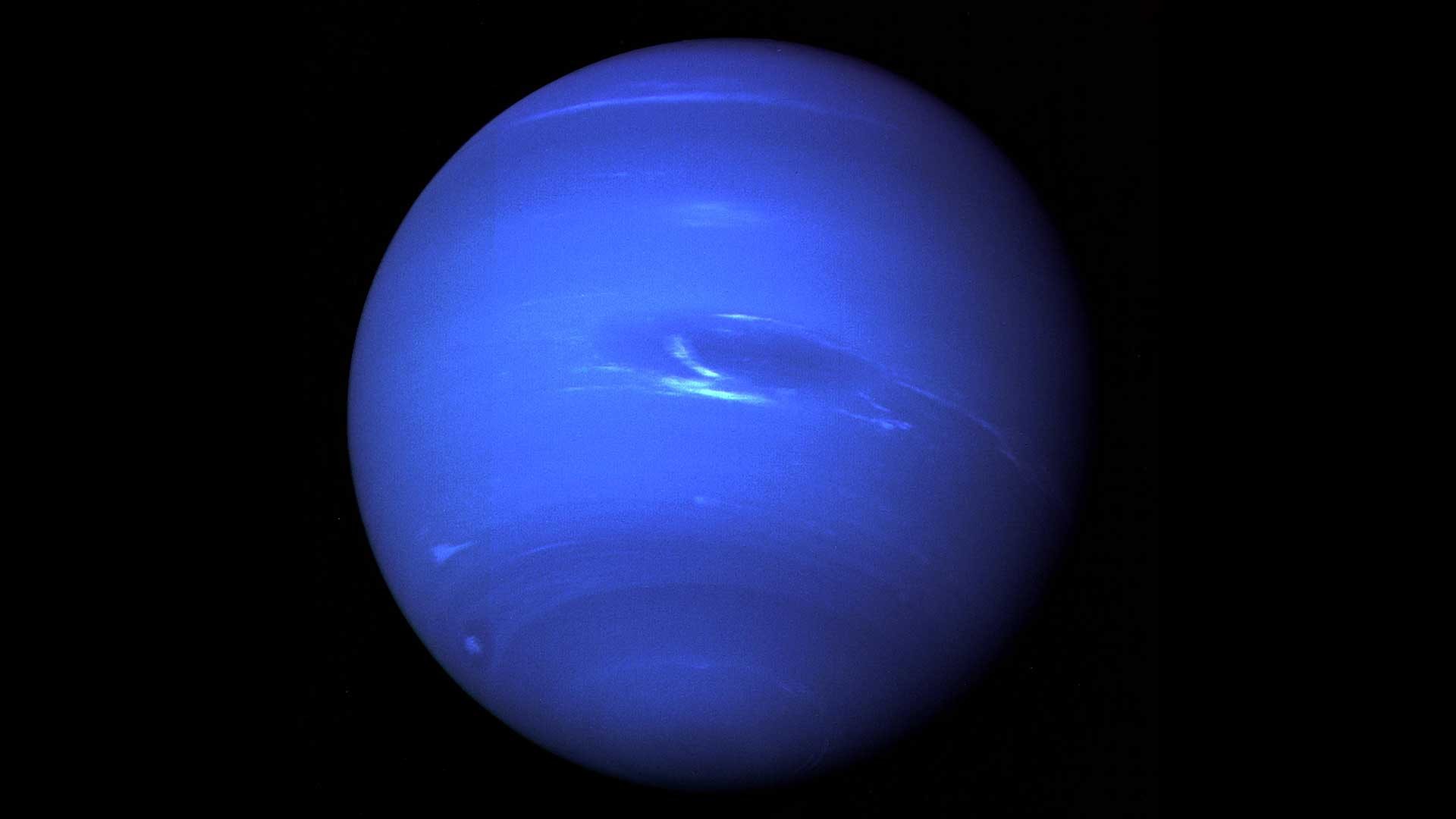Neptune’s size compared to Earth is substantial, with Neptune being approximately four times wider than our home planet; therefore, Neptune is significantly larger than Earth. COMPARE.EDU.VN offers a comprehensive exploration of this comparison, detailing the vast differences in size, mass, and other characteristics. This article will guide you through a detailed comparison, shedding light on the contrasting features of these two celestial bodies, including their composition, atmospheric conditions, and orbital properties.
1. Understanding the Basics of Neptune and Earth
1.1. Neptune: The Distant Ice Giant
Neptune, the eighth and farthest known planet from the Sun in our solar system, is an ice giant characterized by its deep blue color and extreme weather conditions. Discovered in 1846, Neptune has captivated scientists and stargazers alike. Its immense size and unique atmospheric phenomena make it a fascinating subject of study. Key features of Neptune include its:
- Composition: Primarily composed of water, ammonia, and methane ices, with a rocky core.
- Atmosphere: Dominated by hydrogen and helium, with traces of methane that give the planet its blue hue.
- Weather: Experiences supersonic winds and massive storms, such as the now-dissipated Great Dark Spot.
1.2. Earth: Our Home Planet
Earth, the third planet from the Sun, is a terrestrial planet uniquely known for supporting life. Its diverse ecosystems, moderate temperatures, and abundant water make it habitable for a wide range of organisms. Key characteristics of Earth include:
- Composition: Primarily composed of iron, nickel, silicon, and oxygen, with a solid and dynamic crust.
- Atmosphere: Composed mainly of nitrogen and oxygen, providing a breathable environment for life.
- Weather: Experiences a variety of weather patterns, including seasons, driven by solar energy and the planet’s rotation.
2. Size and Dimensions: Neptune vs. Earth
2.1. Diameter Comparison
Neptune’s equatorial diameter is approximately 30,775 miles (49,528 kilometers), while Earth’s equatorial diameter is about 7,918 miles (12,742 kilometers). This means Neptune is nearly four times wider than Earth.
2.2. Volume Comparison
Neptune’s volume is about 58 times that of Earth. This immense difference in volume highlights the significant disparity in size between the two planets.
2.3. Mass Comparison
Neptune’s mass is approximately 17 times that of Earth. Despite being less massive than other gas giants like Jupiter and Saturn, Neptune’s mass far exceeds that of Earth.
2.4. Circumference Comparison
Neptune’s circumference at the equator is about 96,240 miles (154,880 kilometers), whereas Earth’s circumference is approximately 24,901 miles (40,075 kilometers). This further illustrates the significant size difference between the two planets.
3. Detailed Size Metrics: A Side-by-Side Comparison
To provide a clearer understanding, here’s a table summarizing the key size metrics of Neptune and Earth:
| Feature | Neptune | Earth |
|---|---|---|
| Equatorial Diameter | 30,775 miles (49,528 kilometers) | 7,918 miles (12,742 kilometers) |
| Volume | About 58 times that of Earth | 1 |
| Mass | About 17 times that of Earth | 1 |
| Circumference | 96,240 miles (154,880 kilometers) | 24,901 miles (40,075 kilometers) |
| Density | 1.64 g/cm³ | 5.51 g/cm³ |


4. Density Differences
4.1. Understanding Density
Density is a measure of mass per unit volume. It provides insights into the composition and structure of a planet.
4.2. Neptune’s Density
Neptune has a density of 1.64 g/cm³. This relatively low density indicates that Neptune is composed mostly of lighter elements and compounds, such as water, ammonia, and methane ices.
4.3. Earth’s Density
Earth has a density of 5.51 g/cm³, which is significantly higher than Neptune’s. This high density suggests a composition of heavier elements, such as iron and nickel, concentrated in its core.
4.4. Implications of Density Differences
The difference in density between Neptune and Earth reflects their distinct compositions and internal structures. Earth’s dense core and rocky mantle contribute to its higher overall density, while Neptune’s icy composition results in a lower density.
5. Comparative Mass and Gravity
5.1. Mass and Gravitational Force
Mass is a fundamental property of matter, and it directly influences the gravitational force a planet exerts. The more massive a planet, the stronger its gravitational pull.
5.2. Neptune’s Mass and Gravity
Neptune’s mass is about 17 times that of Earth, resulting in a surface gravity that is approximately 1.14 times stronger than Earth’s. This means that an object weighing 100 pounds on Earth would weigh about 114 pounds on Neptune.
5.3. Earth’s Mass and Gravity
Earth’s mass is the baseline for comparison, and its surface gravity is defined as 1 G (standard gravity). This provides a familiar reference point for understanding the gravitational forces on other planets.
5.4. Comparative Effects of Gravity
While Neptune’s gravity is stronger than Earth’s, the difference is not as extreme as the mass ratio might suggest. This is because Neptune’s larger radius distributes its mass over a greater volume, reducing the surface gravity relative to its mass.
6. Internal Structure: Contrasting Layers
6.1. Neptune’s Internal Layers
Neptune’s internal structure consists of three main layers:
- Atmosphere: Primarily hydrogen and helium with traces of methane.
- Mantle: A hot, dense fluid of “icy” materials such as water, methane, and ammonia.
- Core: A small, rocky core with about the same mass as Earth.
6.2. Earth’s Internal Layers
Earth’s internal structure is divided into four main layers:
- Crust: A solid, outermost layer composed of rock.
- Mantle: A semi-solid layer of silicate rock.
- Outer Core: A liquid layer of iron and nickel.
- Inner Core: A solid sphere of iron and nickel.
6.3. Comparative Analysis of Internal Structures
The key differences in internal structure between Neptune and Earth are:
- Composition: Neptune is dominated by “icy” materials, while Earth is composed of rocky and metallic elements.
- Core Size: Neptune’s core is relatively small compared to its overall size, while Earth’s core is a significant portion of its interior.
- Layer States: Neptune lacks a solid surface and has a fluid mantle, while Earth has a solid crust and a semi-solid mantle.
7. Atmospheric Conditions: Winds and Weather
7.1. Neptune’s Atmosphere
Neptune’s atmosphere is characterized by:
- Composition: Primarily hydrogen and helium with traces of methane.
- Winds: Supersonic winds reaching speeds of over 1,200 miles per hour (2,000 kilometers per hour).
- Storms: Historical presence of massive storms like the Great Dark Spot.
7.2. Earth’s Atmosphere
Earth’s atmosphere is defined by:
- Composition: Primarily nitrogen and oxygen.
- Winds: Moderate winds, generally not exceeding 250 miles per hour (400 kilometers per hour).
- Weather: Diverse weather patterns, including seasons, hurricanes, and tornadoes.
7.3. Comparison of Atmospheric Phenomena
The atmospheric conditions on Neptune and Earth are vastly different:
- Wind Speeds: Neptune’s winds are significantly faster than Earth’s.
- Storm Intensity: Neptune experiences massive, long-lasting storms, while Earth’s storms are generally smaller and shorter-lived.
- Atmospheric Composition: Earth’s atmosphere supports life, while Neptune’s is inhospitable.
8. Orbital Characteristics: Distance and Year Length
8.1. Neptune’s Orbit
Neptune orbits the Sun at an average distance of 2.8 billion miles (4.5 billion kilometers), or 30 astronomical units (AU). One Neptunian year (the time it takes to orbit the Sun) is about 165 Earth years.
8.2. Earth’s Orbit
Earth orbits the Sun at an average distance of 93 million miles (150 million kilometers), or 1 AU. One Earth year is 365.25 days.
8.3. Orbital Comparison
The orbital differences between Neptune and Earth are substantial:
- Distance from the Sun: Neptune is 30 times farther from the Sun than Earth.
- Year Length: Neptune’s year is 165 times longer than Earth’s year.
- Orbital Speed: Earth orbits the Sun much faster than Neptune due to its closer proximity.
9. Moons and Rings: Satellite Systems
9.1. Neptune’s Moons and Rings
Neptune has 16 known moons, with Triton being the largest and most notable. Triton orbits Neptune in a retrograde direction, suggesting it was captured from the Kuiper Belt. Neptune also has at least five main rings and four prominent ring arcs.
9.2. Earth’s Moon
Earth has one natural satellite, the Moon, which is relatively large compared to Earth. The Moon plays a significant role in stabilizing Earth’s axial tilt and influencing tides.
9.3. Comparison of Satellite Systems
Key differences between Neptune’s and Earth’s satellite systems include:
- Number of Moons: Neptune has many more moons than Earth.
- Ring Systems: Neptune has a complex ring system, while Earth has no rings.
- Moon Size: Earth’s Moon is relatively large compared to Earth, while Neptune’s moons are smaller relative to Neptune.
10. Surface Features and Habitability
10.1. Neptune’s Surface
Neptune does not have a solid surface. Its atmosphere extends to great depths, gradually merging into water and other melted ices over a heavier, solid core.
10.2. Earth’s Surface
Earth has a solid surface composed of continents, oceans, and polar ice caps. Its diverse surface features support a wide range of ecosystems and life forms.
10.3. Comparative Habitability
Neptune’s environment is not conducive to life as we know it, due to extreme temperatures, pressures, and volatile materials. Earth, on the other hand, is uniquely habitable, with moderate temperatures, liquid water, and a protective atmosphere.
11. Magnetic Fields: Planetary Magnetospheres
11.1. Neptune’s Magnetosphere
Neptune’s magnetic field is tilted about 47 degrees compared to its rotation axis, causing significant variations during each rotation. The magnetic field is about 27 times more powerful than Earth’s.
11.2. Earth’s Magnetosphere
Earth’s magnetic field is generated by the movement of molten iron in its outer core. It protects the planet from harmful solar wind and cosmic radiation.
11.3. Comparison of Magnetospheres
The key differences between Neptune’s and Earth’s magnetospheres are:
- Tilt Angle: Neptune’s magnetic field is significantly tilted compared to Earth’s.
- Field Strength: Neptune’s magnetic field is much stronger than Earth’s.
- Generation Mechanism: Both are generated by internal processes, but the specific dynamics differ.
12. Missions and Exploration: Unveiling the Mysteries
12.1. Neptune Exploration
The primary mission to Neptune was the Voyager 2 flyby in 1989, which provided valuable data and images of the planet, its moons, and rings. Future missions are being considered to further explore Neptune and its system.
12.2. Earth Exploration
Earth has been extensively studied through numerous satellite missions, ground-based observations, and human exploration. These efforts have provided a detailed understanding of Earth’s geology, climate, and life.
12.3. Comparative Exploration Efforts
The exploration of Neptune is limited compared to the extensive study of Earth. Future missions to Neptune could reveal new insights into the ice giant’s composition, dynamics, and history.
13. Visual Perspective: Imagining the Scale
13.1. Visualizing Neptune’s Size
Imagine placing four Earths side by side; that’s approximately the diameter of Neptune. Visualizing this scale helps to appreciate the sheer size difference between the two planets.
13.2. Visualizing Mass and Density
Consider filling 58 Earths with Neptune-like material to match Neptune’s volume. However, you would still need 17 Earths to match Neptune’s mass. This illustrates the density differences between the two planets.
13.3. Putting it into Perspective
These visual comparisons provide a tangible sense of the scale and characteristics of Neptune relative to our home planet, Earth.
14. Unique Features of Neptune
14.1. The Great Dark Spot
The Great Dark Spot was a massive storm in Neptune’s southern hemisphere, similar to Jupiter’s Great Red Spot. Discovered in 1989 by Voyager 2, it was large enough to contain the entire Earth. The storm has since disappeared, but new storms have appeared on different parts of the planet.
14.2. Retrograde Orbit of Triton
Neptune’s largest moon, Triton, has a retrograde orbit, meaning it orbits Neptune in the opposite direction of the planet’s rotation. This unique characteristic suggests that Triton was likely captured from the Kuiper Belt.
14.3. Supersonic Winds
Neptune’s atmosphere experiences supersonic winds, reaching speeds of over 1,200 miles per hour (2,000 kilometers per hour). These are some of the fastest winds recorded in the solar system.
15. Implications for Understanding Planetary Formation
15.1. Formation Theories
Studying Neptune and comparing it to Earth provides valuable insights into the formation and evolution of planetary systems. Current theories suggest that Neptune formed closer to the Sun and migrated outward, influencing the orbits of other planets.
15.2. Composition and Structure
The composition and structure of Neptune, particularly its icy mantle and relatively small core, offer clues about the conditions and processes that occurred during the early solar system.
15.3. Comparative Planetology
Comparing Neptune and Earth helps scientists understand the range of possible planetary outcomes, from small, rocky, habitable planets to large, icy, inhospitable giants.
16. Open Questions and Future Research
16.1. Unresolved Mysteries
Many mysteries about Neptune remain unresolved, including the origin of its tilted magnetic field, the dynamics of its atmospheric storms, and the composition of its interior.
16.2. Future Missions
Future missions to Neptune could provide new data to answer these questions and deepen our understanding of this distant ice giant. Potential missions include advanced probes, orbiters, and atmospheric entry vehicles.
16.3. Research Directions
Ongoing research efforts include studying Neptune’s atmosphere, magnetic field, and internal structure using remote sensing data, computer simulations, and laboratory experiments.
17. Neptune in Pop Culture and Mythology
17.1. Neptune in Mythology
Neptune is named after the Roman god of the sea, reflecting its deep blue color and vast, mysterious nature. The name connects the planet to themes of water, depth, and the unknown.
17.2. Neptune in Literature and Film
Neptune has appeared in various works of science fiction, often portrayed as a remote and enigmatic world. Its extreme conditions and unique characteristics make it a compelling setting for imaginative stories.
17.3. Cultural Significance
Neptune’s cultural significance lies in its role as a symbol of the distant, unexplored frontiers of our solar system. It represents the challenges and possibilities of space exploration and the human quest for knowledge.
18. Conclusion: Appreciating the Differences
18.1. Recap of Key Differences
Neptune is significantly larger than Earth, with about 58 times the volume and 17 times the mass. Its icy composition, extreme weather, and distant orbit make it a vastly different world from our own.
18.2. Importance of Comparative Studies
Comparing Neptune and Earth provides valuable insights into the diversity of planetary systems and the conditions that support life. These studies help us understand our place in the universe and the possibilities beyond our home planet.
18.3. Final Thoughts
As we continue to explore and study Neptune, we gain a deeper appreciation for the unique characteristics of our solar system and the endless wonders of the cosmos.
19. FAQs: Neptune’s Size and Characteristics
19.1. How Big Is Neptune Compared to Earth?
Neptune is approximately four times wider than Earth, with about 58 times the volume and 17 times the mass.
19.2. What Is Neptune Made Of?
Neptune is primarily composed of water, ammonia, and methane ices, with a rocky core.
19.3. Does Neptune Have a Solid Surface?
No, Neptune does not have a solid surface. Its atmosphere extends to great depths, gradually merging into water and other melted ices.
19.4. How Long Is a Year on Neptune?
One year on Neptune is about 165 Earth years.
19.5. How Far Is Neptune from the Sun?
Neptune is an average of 2.8 billion miles (4.5 billion kilometers) from the Sun.
19.6. Does Neptune Have Rings?
Yes, Neptune has at least five main rings and four prominent ring arcs.
19.7. How Strong Is Neptune’s Gravity Compared to Earth’s?
Neptune’s surface gravity is about 1.14 times stronger than Earth’s.
19.8. What Is the Temperature on Neptune?
The average temperature on Neptune is around minus 328 degrees Fahrenheit (minus 200 degrees Celsius).
19.9. How Many Moons Does Neptune Have?
Neptune has 16 known moons, with Triton being the largest.
19.10. Can Humans Visit Neptune?
While theoretically possible, a human mission to Neptune is extremely challenging due to the planet’s distance, extreme conditions, and lack of a solid surface.
20. Call to Action
Ready to explore more detailed comparisons and make informed decisions? Visit COMPARE.EDU.VN today to discover a wealth of information and resources. Whether you’re comparing celestial bodies, consumer products, or educational opportunities, COMPARE.EDU.VN provides the objective insights you need.
Address: 333 Comparison Plaza, Choice City, CA 90210, United States
Whatsapp: +1 (626) 555-9090
Website: compare.edu.vn
